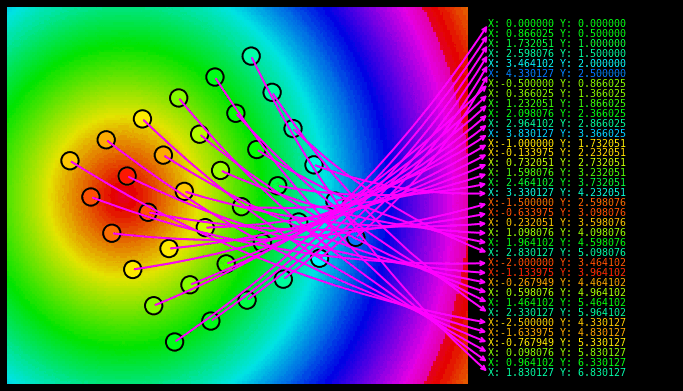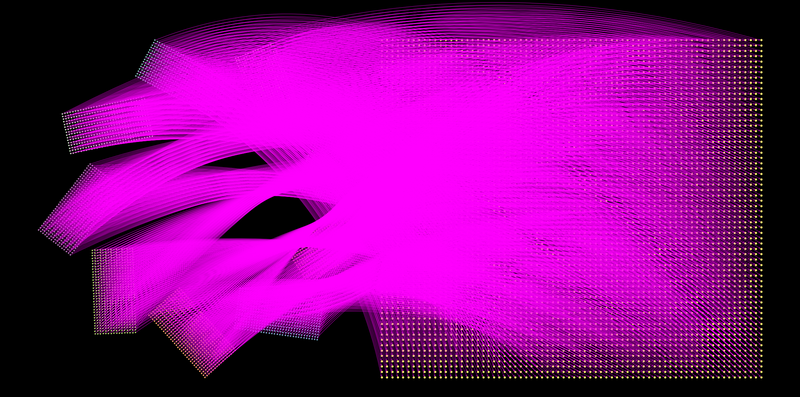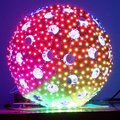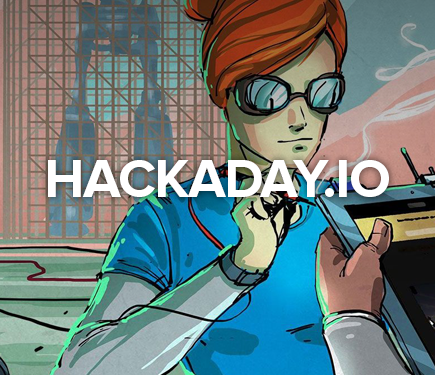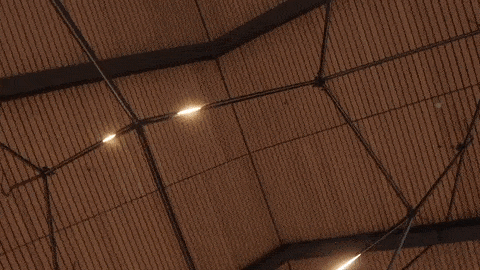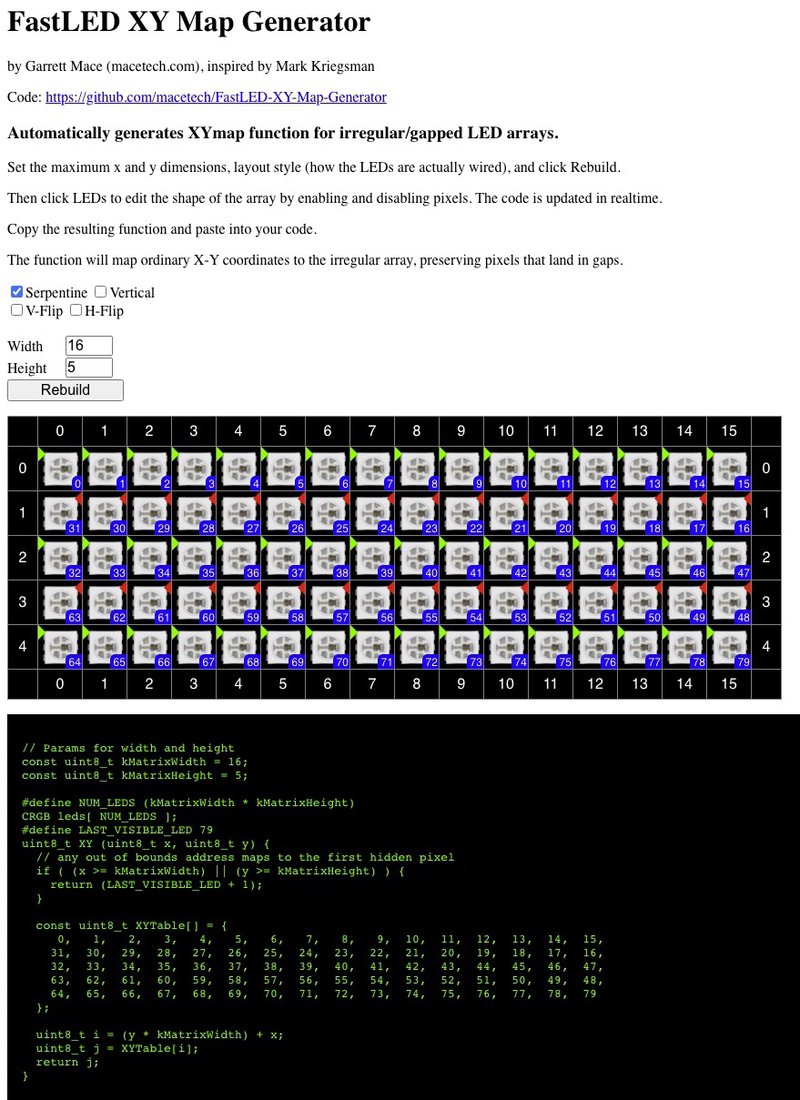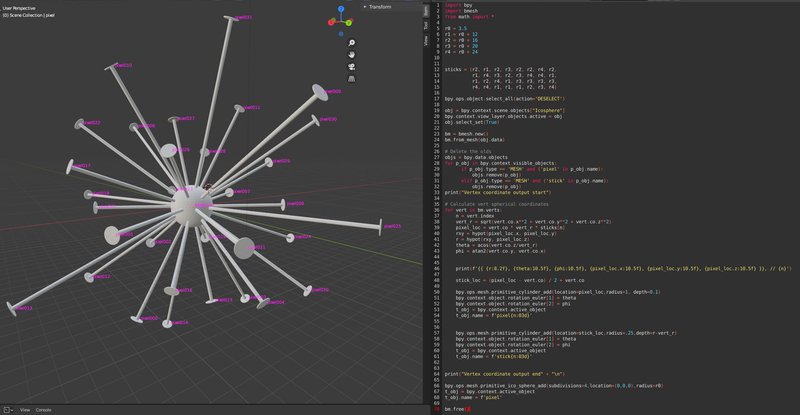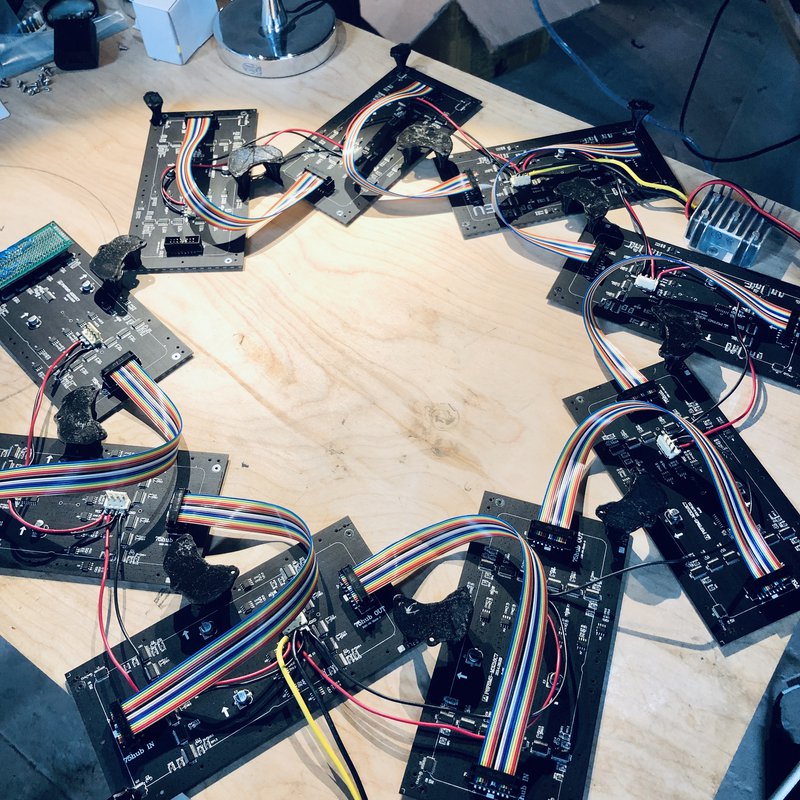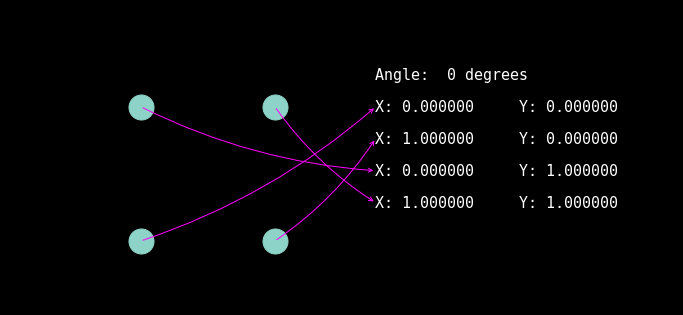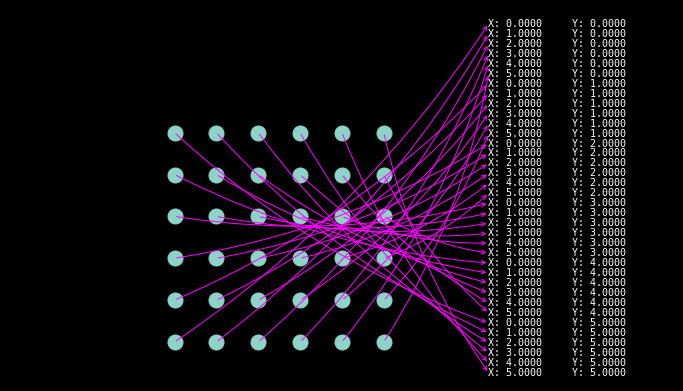-
Hack Chat Transcript, Part 2
06/09/2021 at 19:55 • 0 comments![]()
![]() @Jason Moungey that's a disco stick if I've ever seen one!
@Jason Moungey that's a disco stick if I've ever seen one!![]() Either way I am in love with it
Either way I am in love with it![]() @Steve Pomeroy :)))))
@Steve Pomeroy :)))))![]() Once you do your transforms, you can step through the physical pixels you have, pull out their coordinates of interest, and feed that into your generation algorithm
Once you do your transforms, you can step through the physical pixels you have, pull out their coordinates of interest, and feed that into your generation algorithm![]()
![]()
![]() I'm loving these explainer gifs!
I'm loving these explainer gifs!![]() I definitely recommend perusing some old math texts, maybe Khan Academy or something...it really helps! And I do love my Python and matplotlib!
I definitely recommend perusing some old math texts, maybe Khan Academy or something...it really helps! And I do love my Python and matplotlib!![]() @Dan Maloney are we still saving HackChat transcripts?
@Dan Maloney are we still saving HackChat transcripts?![]() @Garrett Mace what did you end up using to make these explainer gifs? good stuff
@Garrett Mace what did you end up using to make these explainer gifs? good stuff![]() What software are you using to simulate your end result?
What software are you using to simulate your end result?![]() Most of the patterns on that LED Nonagon are very simple. I have it run through the pixels and feed coordinates to generator classes. The core algorithm for many patterns is a oneliner
Most of the patterns on that LED Nonagon are very simple. I have it run through the pixels and feed coordinates to generator classes. The core algorithm for many patterns is a oneliner![]()
1
CRGB render(pixel_info pix) {2
int8_t color = (int32_t)(pix.r/12*(int32_t)(sin16(angle))/256) + pix.angle*256/PI*1;
3
CRGB ret_color;
4
ret_color = ColorFromPalette(palette, color+hue, 255);
5
return ret_color;
6
}
![]() Ben: I'm rendering them in Matplotlib, frame by frame, from within jupyter notebook
Ben: I'm rendering them in Matplotlib, frame by frame, from within jupyter notebook![]() reynolds: I usually dev actual patterns on the device itself. However, there are some great FastLED simulator projects on github
reynolds: I usually dev actual patterns on the device itself. However, there are some great FastLED simulator projects on github![]() I know hackaday posted one pretty recently?
I know hackaday posted one pretty recently?![]() I would like to figure out how to feed LED algorithms directly into Blender and render the results in EEvee
I would like to figure out how to feed LED algorithms directly into Blender and render the results in EEvee![]() In any case....if you precalculate the math, use a "shader" style approach to generating physical-space patterns, you might forget the actual complexity looks like this:
In any case....if you precalculate the math, use a "shader" style approach to generating physical-space patterns, you might forget the actual complexity looks like this:![]() That would be slick, and thanks I will have a look around on github for some simulators
That would be slick, and thanks I will have a look around on github for some simulators![]()
![]()
![]() Do you do most of your project mockups/renders in Blender?
Do you do most of your project mockups/renders in Blender?![]() 😱
😱![]() Steve: I've done a few, but definitely not most. Lots of pencil sketches, and some guesstimations
Steve: I've done a few, but definitely not most. Lots of pencil sketches, and some guesstimations![]() Gotcha. I've been trying to figure out a good workflow for LED-based sim there. Sounds like Eevee? :-)
Gotcha. I've been trying to figure out a good workflow for LED-based sim there. Sounds like Eevee? :-)![]() You can build the thing, and then measure where the pixels are, or where a strip starts and ends and what the pixel spacing is
You can build the thing, and then measure where the pixels are, or where a strip starts and ends and what the pixel spacing is![]() 🤯 Incredible images! Maybe a chicken and egg question, but did you have the mathematics background when you started doing animations or did it evolve from these projects?
🤯 Incredible images! Maybe a chicken and egg question, but did you have the mathematics background when you started doing animations or did it evolve from these projects?![]() Eevee is a graphics-card based render option in newest Blender releases, it's a lot faster
Eevee is a graphics-card based render option in newest Blender releases, it's a lot faster![]() LqqkOut I graduated as an EE with pretty heavy math along the way, but that was almost 20 years ago. Knowing where to look helped (hence this hack chat) but I did have to relearn a lot
LqqkOut I graduated as an EE with pretty heavy math along the way, but that was almost 20 years ago. Knowing where to look helped (hence this hack chat) but I did have to relearn a lot![]() Any other questions about the above projects, approaches to LED mapping, how to even use this, or random thoughts about the state of LED tech today?
Any other questions about the above projects, approaches to LED mapping, how to even use this, or random thoughts about the state of LED tech today?![]() I found this bit to be really good at explaining transformation matrix math: https://developer.mozilla.org/en-US/docs/Web/API/WebGL_API/Matrix_math_for_the_web
I found this bit to be really good at explaining transformation matrix math: https://developer.mozilla.org/en-US/docs/Web/API/WebGL_API/Matrix_math_for_the_web![]() That looks pretty good! I'm thinking about switching to Javascript (as in your link) because I think it'll be a bit more performant, easier to share, interactive
That looks pretty good! I'm thinking about switching to Javascript (as in your link) because I think it'll be a bit more performant, easier to share, interactive![]() I mean look at all this cool stuff: https://www.falstad.com/mathphysics.html
I mean look at all this cool stuff: https://www.falstad.com/mathphysics.html![]() (hold for later if it's coming up!) Any lessons-learned or tips re: power and power distribution? I imagine these can be pretty hungry
(hold for later if it's coming up!) Any lessons-learned or tips re: power and power distribution? I imagine these can be pretty hungry![]() Yes
Yes![]() are you using normal vectors for LED orientations in your 3d animations as well? (I've been using them to simulate artificial light sources, where the LEDs simulate reflective surfaces)
are you using normal vectors for LED orientations in your 3d animations as well? (I've been using them to simulate artificial light sources, where the LEDs simulate reflective surfaces)![]() I don't have more loaded into the chat cannon, so we're well into freeform chat now
I don't have more loaded into the chat cannon, so we're well into freeform chat now![]() LqqkOut: I stick with 48V or lower distribution, and point-of-load DC-DC converters for large projects
LqqkOut: I stick with 48V or lower distribution, and point-of-load DC-DC converters for large projects![]() Each node in that ceiling project needed to handle up to 400 watts
Each node in that ceiling project needed to handle up to 400 watts![]() More of a hardware question. The link someone posted for the ceiling LED project mentioned "custom connectors". With the huge range of connectors available, why would it have to be something custom? And how does one get custom connectors made?
More of a hardware question. The link someone posted for the ceiling LED project mentioned "custom connectors". With the huge range of connectors available, why would it have to be something custom? And how does one get custom connectors made?![]()
https://www.tangibleinteraction.com/artworks/summit
summit
Garibaldi Mountain is one of the greatest natural beauties in British Columbia, towering majestically above the small town of Squamish. Every time you drive by or see it in the distance, the extraordinary view of the impressively peaked ridge inherently steals your breath away.
Read this on summit | Tangible Interaction
![]() brainsmoke: I haven't needed to worry about normal vectors yet, but on that summit project they were very important. We had the three sides of the sticks modeled, and wanted self-shadowing effects so we needed to know what direction each LED pointed
brainsmoke: I haven't needed to worry about normal vectors yet, but on that summit project they were very important. We had the three sides of the sticks modeled, and wanted self-shadowing effects so we needed to know what direction each LED pointed![]() The person who set that up was a data scientist, I definitely recommend getting one on the team if you have a similar scale of problem!
The person who set that up was a data scientist, I definitely recommend getting one on the team if you have a similar scale of problem!![]() Any thoughts on MicroPython on the microcontrollers you use?
Any thoughts on MicroPython on the microcontrollers you use?![]() Dan: The custom connectors were mostly to handle the long strips we were using, the default connectors were not strong enough or high enough current for a semi-industrial application. So custom was mostly "hey Ray Wu, can you put these on instead" and he said yeah
Dan: The custom connectors were mostly to handle the long strips we were using, the default connectors were not strong enough or high enough current for a semi-industrial application. So custom was mostly "hey Ray Wu, can you put these on instead" and he said yeah![]() grcornwe: Loving MicroPython. I haven't used it for a high-update-rate LED application yet, but for small info display type projects it's so nice to not dig deep into C to handle network comms, text processing etc
grcornwe: Loving MicroPython. I haven't used it for a high-update-rate LED application yet, but for small info display type projects it's so nice to not dig deep into C to handle network comms, text processing etc![]() One of the things I've heard people talk about in terms of pixel mapping is the idea of using a network of smarter pixel drivers + more parametric control signals instead of raw pixel data. Have you explored that at all?
One of the things I've heard people talk about in terms of pixel mapping is the idea of using a network of smarter pixel drivers + more parametric control signals instead of raw pixel data. Have you explored that at all?![]() Thanks, I've been struggling with a higher-update-rate application, drove me back to C :)
Thanks, I've been struggling with a higher-update-rate application, drove me back to C :)![]() The micropython and circuitpython implementations have high speed pixel drivers under the hood. Might be cool to do a similar approach with a lookup table and shader kernels written in C
The micropython and circuitpython implementations have high speed pixel drivers under the hood. Might be cool to do a similar approach with a lookup table and shader kernels written in C![]() I've written a jitter-hiding driver for micropython, to hide garbage collection cycles :-)
I've written a jitter-hiding driver for micropython, to hide garbage collection cycles :-)![]() (I imagine the idea of JPEG-like frames being sent to a controller instead of raw pixels.)
(I imagine the idea of JPEG-like frames being sent to a controller instead of raw pixels.)![]() Steve: Sort of a game of life approach? Rules-based pattern generation? I haven't done that but see great things on twitter with interchangeable modules
Steve: Sort of a game of life approach? Rules-based pattern generation? I haven't done that but see great things on twitter with interchangeable modules![]() That is a fourth approach to the problem though. I know that Paul does demos with a rectangular array from a Teensy, and a computer pipes pixel data to it over USB. However, you could do the heavy processing on the computer and send pre-mapped data to pixel chains or strings
That is a fourth approach to the problem though. I know that Paul does demos with a rectangular array from a Teensy, and a computer pipes pixel data to it over USB. However, you could do the heavy processing on the computer and send pre-mapped data to pixel chains or strings![]() Are most of your projects for specific clients or are they personal projects? If clients, do you get to design collaboratively or is it more prescriptive?
Are most of your projects for specific clients or are they personal projects? If clients, do you get to design collaboratively or is it more prescriptive?![]() There are a lot of commercial applications that do this, mostly with DMX but some Artnet
There are a lot of commercial applications that do this, mostly with DMX but some Artnet![]() LqqkOut: It's definitely more personal projects these days, or no-money projects (collab with Burning Man sculptor etc)
LqqkOut: It's definitely more personal projects these days, or no-money projects (collab with Burning Man sculptor etc)![]() [thank you for all of the answers, I wish the chat had response icons to show the love]
[thank you for all of the answers, I wish the chat had response icons to show the love]![]() Maybe someday
Maybe someday![]() It'll be next to the edit button
It'll be next to the edit button![]() haha
haha![]() good stuff
good stuff![]() thanks, @Garrett Mace
thanks, @Garrett Mace![]() If it's all right, I'm going to grab some lunch. If you'd like to continue discussion over the next few days, or have questions for many other experienced LED artists and coders, hop over to the LED Art Ongoing/Weekly Chat
If it's all right, I'm going to grab some lunch. If you'd like to continue discussion over the next few days, or have questions for many other experienced LED artists and coders, hop over to the LED Art Ongoing/Weekly Chat![]() Indeed, thanks so much!
Indeed, thanks so much!![]()
https://hackaday.io/messages/room/289684
Public chat for LED Art Ongoing/Weekly Chat | Hackaday.io
Participate in the public chat for LED Art Ongoing/Weekly Chat!
![]() I'll try to spend some more time in there too!
I'll try to spend some more time in there too!![]() 👍
👍![]() Thank you all for a great discussion and great questions!
Thank you all for a great discussion and great questions!![]() Sounds goos Garrett, we're almost at the end of the hour anyway.
Sounds goos Garrett, we're almost at the end of the hour anyway.![]() *good
*good![]() Great chat Garrett, and thanks for linking to the LED Art Chat group!
Great chat Garrett, and thanks for linking to the LED Art Chat group!![]() Thanks so much for dropping by today, interesting stuff. I never thought there's be so much math involved, but it makes sense once you think about it.
Thanks so much for dropping by today, interesting stuff. I never thought there's be so much math involved, but it makes sense once you think about it.![]() Thanks for inviting me, Dan. Was a lot of fun!
Thanks for inviting me, Dan. Was a lot of fun!![]() favorite c matrix math library? I've picked up https://github.com/felselva/mathc - seems a good mix of simple, capable, and fast
favorite c matrix math library? I've picked up https://github.com/felselva/mathc - seems a good mix of simple, capable, and fast![]() Thanks @Garrett Mace and everyone!
Thanks @Garrett Mace and everyone!![]() Thank you Garrett!
Thank you Garrett!![]() You bet. And thanks all for turning out today with great questions.
You bet. And thanks all for turning out today with great questions.![]() Ben: I'm doing the math in Python so that I don't have to do it in C :) Uh, eventually will probably need that though. Thanks for the link!
Ben: I'm doing the math in Python so that I don't have to do it in C :) Uh, eventually will probably need that though. Thanks for the link!![]() Next week we'll be talking with Cory Collins about Art with Technology:
Next week we'll be talking with Cory Collins about Art with Technology:![]()
https://hackaday.io/event/179425-art-with-technology-hack-chat
Art with Technology Hack Chat
Cory Collins will host the Hack Chat on Wednesday, June 16 at noon Pacific. Time zones got you down? Try our handy time zone converter. As hackers, we naturally see the beauty of technology.
![]() Transcript for today's chat coming right up...
Transcript for today's chat coming right up...![]() thanks - I only caught little parts of this - looking forward to reading the transcript later tonight
thanks - I only caught little parts of this - looking forward to reading the transcript later tonight![]() Smae
Smae![]() Er, same
Er, same -
Hack Chat Transcript, Part 1
06/09/2021 at 19:54 • 0 comments![]() OK, people are still coming in but I think we can get started. Hello everyone, thanks for coming out today. I'm Dan and I'll be moderating along with Dusan today as we welcome Garrett Mace to the Hack Chat. We'll be talking about cool tricks to making LED matrix project easier and better.
OK, people are still coming in but I think we can get started. Hello everyone, thanks for coming out today. I'm Dan and I'll be moderating along with Dusan today as we welcome Garrett Mace to the Hack Chat. We'll be talking about cool tricks to making LED matrix project easier and better.![]() Hey everyone!
Hey everyone!![]() Hi Garrett! Can you tell us a little about how LEDs became your thing?
Hi Garrett! Can you tell us a little about how LEDs became your thing?![]() Hello and welcome!
Hello and welcome!![]() They always were! I started experimenting with electronics while LEDs existed, so my first circuits of course blinked an LED or two
They always were! I started experimenting with electronics while LEDs existed, so my first circuits of course blinked an LED or two![]() "Hello world" of hardware, right?
"Hello world" of hardware, right?![]() Once you go from one LED to two LEDs, it's a slippery slope. You never come back!
Once you go from one LED to two LEDs, it's a slippery slope. You never come back!![]() I have some intro material if it's OK to launch it?
I have some intro material if it's OK to launch it?![]() Yeah, go for it
Yeah, go for it![]() Hi, I'm Garrett Mace of macetech.com. I work on lots of projects, but in this chat will focus on LED stuff. Specifically LED matrixes, non-rectangular LED arrays, and LED matrixes in non-rectangular arrays ;) Here are some examples of projects I've worked on:
Hi, I'm Garrett Mace of macetech.com. I work on lots of projects, but in this chat will focus on LED stuff. Specifically LED matrixes, non-rectangular LED arrays, and LED matrixes in non-rectangular arrays ;) Here are some examples of projects I've worked on:![]()
![]()
![]()
![]()
![]()
![]()
![]()
![]()
![]() So you can see that while some of them involve 1D and 2D LED arrays, they may not confirm to regular grids
So you can see that while some of them involve 1D and 2D LED arrays, they may not confirm to regular grids![]() Whoa - just the logisitics of installing that ceiling project must be a story worth telling.
Whoa - just the logisitics of installing that ceiling project must be a story worth telling.![]() This poses several problems, if you want to make your LED animations make sense in the physical world
This poses several problems, if you want to make your LED animations make sense in the physical world![]() The ceiling install was a lot of fun: I got to design and order custom extrusion for example!
The ceiling install was a lot of fun: I got to design and order custom extrusion for example!![]() neat
neat![]() We used about 35 networked Teensy 3.6's (thanks Paul)
We used about 35 networked Teensy 3.6's (thanks Paul)![]() :)
:)![]() And 3D mapping done with Touch Designer. This was a collab with Tangible Interaction up in Vancouver BC
And 3D mapping done with Touch Designer. This was a collab with Tangible Interaction up in Vancouver BC![]() Who did you design the ceiling light show for?
Who did you design the ceiling light show for?![]() Nice! Do you have any tips/tricks for LED mapping with TouchDesigner? Or resources that explain it well to beginners? (I'm teaching a workshop on doing LED art with TouchDesigner now and looking for intro resources)
Nice! Do you have any tips/tricks for LED mapping with TouchDesigner? Or resources that explain it well to beginners? (I'm teaching a workshop on doing LED art with TouchDesigner now and looking for intro resources)![]() TD definitely seems to be the leader in lots of LED projects I see. They keep popping up. A bit of a learning curve, but it's soooo powerful!
TD definitely seems to be the leader in lots of LED projects I see. They keep popping up. A bit of a learning curve, but it's soooo powerful!![]() That was a sort of office HQ for a development up in the Squamish wilds. We had a bear alert on site and had to hide!
That was a sort of office HQ for a development up in the Squamish wilds. We had a bear alert on site and had to hide!![]() Steve: On Touch Designer we had someone else do the intense 3D mapping
Steve: On Touch Designer we had someone else do the intense 3D mapping![]() Gotcha. Understandable, it can get pretty hairy!
Gotcha. Understandable, it can get pretty hairy!![]() Besides TD, any other tools/techniques you find useful for working with non-rectangular matrices?
Besides TD, any other tools/techniques you find useful for working with non-rectangular matrices?![]() It was a very complex setup that mapped stick points into 3D space, mapped patterns onto a model of the actual install
It was a very complex setup that mapped stick points into 3D space, mapped patterns onto a model of the actual install![]() @Dan Maloney can we ask questions here or do we have to fill out the Google Sheet (if we still do that)?
@Dan Maloney can we ask questions here or do we have to fill out the Google Sheet (if we still do that)?![]() I believe he was projecting textures onto the sticks and extracting them to LED colors
I believe he was projecting textures onto the sticks and extracting them to LED colors![]() @Orlando Hoilett - ask away! No formalities here!
@Orlando Hoilett - ask away! No formalities here!![]() nice ceiling effect! was that mapped to some kind of cartesian space or work on some kind of connection topology?
nice ceiling effect! was that mapped to some kind of cartesian space or work on some kind of connection topology?![]() grcornwe: I have lots of material on that aspect :)
grcornwe: I have lots of material on that aspect :)![]() You can draw shapes pretty easily using (x,y) coordinates just like a computer screen. But what if your project isn't a grid? Maybe it's some other shape, or is distributed within 3D space. The coordinates aren't as predictable, may not be regularly spaced integers...or you might not even want to use Cartesian coordinates.
You can draw shapes pretty easily using (x,y) coordinates just like a computer screen. But what if your project isn't a grid? Maybe it's some other shape, or is distributed within 3D space. The coordinates aren't as predictable, may not be regularly spaced integers...or you might not even want to use Cartesian coordinates.![]() If your grid is still a grid, but has weird shapes (a grid with holes pretty much) I made a tool for that:
If your grid is still a grid, but has weird shapes (a grid with holes pretty much) I made a tool for that:![]()
![]()
![]() @Garrett Mace so would you consider this a "finished" product? I'm curious how the client deals with systems and hardware that are often considered "prototype-friendly" but not necessarily "deployable" friendly, at least in their breakout forms.
@Garrett Mace so would you consider this a "finished" product? I'm curious how the client deals with systems and hardware that are often considered "prototype-friendly" but not necessarily "deployable" friendly, at least in their breakout forms.![]()
https://macetech.github.io/FastLED-XY-Map-Generator/
FastLED XY Map Generator
by Garrett Mace (macetech.com), inspired by Mark Kriegsman Code: https://github.com/macetech/FastLED-XY-Map-Generator Set the maximum x and y dimensions, layout style (how the LEDs are actually wired), and click Rebuild. Then click LEDs to edit the shape of the array by enabling and disabling pixels. The code is updated in realtime.
![]() haha, I think I came across that generator before and didn't know it was you :-)
haha, I think I came across that generator before and didn't know it was you :-)![]() And I mean the ceiling LED light show. (Sorry for asking out of turn...it's hard to find a good place to jump in).
And I mean the ceiling LED light show. (Sorry for asking out of turn...it's hard to find a good place to jump in).![]() Orlando: it was a finished install, but yes: we could really have used OTA. There was a startup reset sync issue on the Teensy that was a bit difficult when you need a lift to go fix it
Orlando: it was a finished install, but yes: we could really have used OTA. There was a startup reset sync issue on the Teensy that was a bit difficult when you need a lift to go fix it![]() Interesting.
Interesting.![]() yuck, yeah OTA would be good
yuck, yeah OTA would be good![]() Other ways to map LEDs to physical space: you can make a 3D model and find a way to extract the LED point coordinates
Other ways to map LEDs to physical space: you can make a 3D model and find a way to extract the LED point coordinates![]() I would love to see a picture of the hardware brains. 35 Teensys is pretty intense. Lol.
I would love to see a picture of the hardware brains. 35 Teensys is pretty intense. Lol.![]()
![]()
![]() 35 teensy's working together in concert? wow
35 teensy's working together in concert? wow![]() are the teensy boards are connected to a computer which provides the display data? if so, what interface does that use
are the teensy boards are connected to a computer which provides the display data? if so, what interface does that use![]() I made an LED project for my house, and modeled it in Blender. Sometimes you can just draw your object in a 3D CAD program and extract the coordinates directly.In the following case I used Blender to generate some of the geometry, and calculated an X, Y, Z, radius, theta, and phi angle lookup table.
I made an LED project for my house, and modeled it in Blender. Sometimes you can just draw your object in a 3D CAD program and extract the coordinates directly.In the following case I used Blender to generate some of the geometry, and calculated an X, Y, Z, radius, theta, and phi angle lookup table.![]() Are the LED Matrix Shades a kit or do they come already assembled?
Are the LED Matrix Shades a kit or do they come already assembled?![]() anfractuosity: Yep, all ethernet to a pretty intense server :) SACN was not able to keep up so I had to write my own trimmed down protocol
anfractuosity: Yep, all ethernet to a pretty intense server :) SACN was not able to keep up so I had to write my own trimmed down protocol![]() Simon: those are pre assembled, the RGB Shades are optional assembled
Simon: those are pre assembled, the RGB Shades are optional assembled![]() For the 3D model above, the lookup table looks like this:
For the 3D model above, the lookup table looks like this:![]() @Garrett Mace You type so fast! I was gonna answer that one :p
@Garrett Mace You type so fast! I was gonna answer that one :p![]() "sACN was not able to keep up"
"sACN was not able to keep up"What pixel count / frame rate were you targeting?
![]() ooh nice, so each teensy board has it's own ethernet jack?
ooh nice, so each teensy board has it's own ethernet jack?![]()
1
// r, phi, theta, x, y, z
2
float spherical_map[32][6] = {3
{ 19.50, 2.58802, 0.00000, 10.25176, 0.00000, -16.58769 }, // 04
{ 15.50, 1.57080, -0.55357, 13.18514, -8.14874, -0.00007 }, // 15
{ 19.50, 2.12437, -1.57079, 0.00016, -16.58766, -10.25181 }, // 26
{ 23.50, 2.58802, 3.14159, -12.35463, 0.00000, -19.99033 }, // 37
{ 19.50, 2.12437, 1.57079, 0.00016, 16.58766, -10.25181 }, // 48
{ 19.50, 1.57080, 0.55357, 16.58776, 10.25164, -0.00009 }, // 59
{ 27.50, 1.01722, -1.57081, -0.00022, -23.39285, 14.45768 }, // 610
{ 19.50, 1.57079, -2.58803, -16.58776, -10.25164, 0.00009 }, // 711
{ 15.50, 1.57079, 2.58803, -13.18514, 8.14874, 0.00007 }, // 812
{ 27.50, 1.01722, 1.57081, -0.00022, 23.39285, 14.45768 }, // 913
{ 23.50, 0.55357, 0.00000, 12.35463, 0.00000, 19.99033 }, // 1014
{ 19.50, 0.55357, 3.14159, -10.25176, 0.00000, 16.58769 }, // 1115
{ 23.50, 2.18628, -0.78539, 13.56782, -13.56756, -13.56780 }, // 1216
{ 27.50, 1.93567, 0.00000, 25.68969, 0.00000, -9.81277 }, // 1317
{ 27.50, 2.77673, -1.57078, 0.00011, -9.81249, -25.68978 }, // 1418
{ 15.50, 2.77673, 1.57078, 0.00006, 5.53068, -14.47970 }, // 1519
{ 15.50, 2.18628, 0.78539, 8.94899, 8.94882, -8.94898 }, // 1620
{ 19.50, 1.20593, 0.00000, 18.21635, 0.00000, 6.95805 }, // 1721
{ 27.50, 1.57080, -1.20593, 9.81269, -25.68971, -0.00000 }, // 1822
{ 15.50, 2.18628, -2.35620, -8.94892, -8.94889, -8.94897 }, // 1923
{ 23.50, 2.18628, 2.35620, -13.56772, 13.56767, -13.56779 }, // 2024
{ 23.50, 1.57080, 1.20593, 8.38539, 21.95303, -0.00000 }, // 2125
{ 23.50, 0.95531, -0.78540, 13.56772, -13.56767, 13.56779 }, // 2226
{ 23.50, 1.57080, -1.93566, -8.38539, -21.95303, 0.00000 }, // 2327
{ 27.50, 1.93566, 3.14159, -25.68973, 0.00000, -9.81263 }, // 2428
{ 27.50, 1.57080, 1.93566, -9.81269, 25.68971, 0.00000 }, // 2529
{ 15.50, 0.95531, 0.78540, 8.94893, 8.94889, 8.94897 }, // 2630
{ 15.50, 0.36486, -1.57081, -0.00006, -5.53068, 14.47970 }, // 2731
{ 15.50, 0.95531, -2.35620, -8.94899, -8.94882, 8.94898 }, // 2832
{ 19.50, 1.20593, 3.14159, -18.21632, 0.00000, 6.95814 }, // 2933
{ 23.50, 0.95531, 2.35620, -13.56782, 13.56756, 13.56780 }, // 3034
{ 27.50, 0.36486, 1.57081, -0.00011, 9.81249, 25.68978 }, // 3135
};
36
37
int pixels_to_verts_map[] = { 5, 22, 17, 10, 27, 9, 26, 25,38
21, 4, 13, 0, 14, 18, 16, 12,
39
23, 2, 24, 3, 15, 8, 7, 19,
40
20, 30, 31, 29, 11, 6, 28, 1};
41
42
typedef struct pixel_info {43
float r;
44
float theta;
45
float phi;
46
float x;
47
float y;
48
float z;
49
} pixel_info;
50
51
52
pixel_info get_pixel_info(int pixel) {53
pixel_info temp_pix;
54
55
temp_pix.r = spherical_map[pixels_to_verts_map[pixel]][0];
56
temp_pix.theta = spherical_map[pixels_to_verts_map[pixel]][1];
57
temp_pix.phi = spherical_map[pixels_to_verts_map[pixel]][2];
58
temp_pix.x = spherical_map[pixels_to_verts_map[pixel]][3];
59
temp_pix.y = spherical_map[pixels_to_verts_map[pixel]][4];
60
temp_pix.z = spherical_map[pixels_to_verts_map[pixel]][5];
61
62
return temp_pix;
63
}
![]() Currently working on a pi pico based hub75 driver. Great performance overall apart from usb. Only issue is to actually get the data fast enough via usb for actual video.
Currently working on a pi pico based hub75 driver. Great performance overall apart from usb. Only issue is to actually get the data fast enough via usb for actual video.uart is fast than its onboard usb cdc port... best might be a ft232h with the parallel fifo
![]() Steve: We had about 42,000 pixels, it was pretty hard to stay above 30fps
Steve: We had about 42,000 pixels, it was pretty hard to stay above 30fps![]() 42,000 is a lot of LEDs.
42,000 is a lot of LEDs.![]() wow, 42K
wow, 42K![]() How do you manage LED failures at that scale?
How do you manage LED failures at that scale?![]() Great question
Great question![]() haha
haha![]() We used a white-white-white strip, and we're only using one channel :)
We used a white-white-white strip, and we're only using one channel :)![]() how do you estimate the framerate you'll be able to get while planning?
how do you estimate the framerate you'll be able to get while planning?![]() We get three chances to fix a burned out LED. If the controller fails though, it's toast and an on-hands repair
We get three chances to fix a burned out LED. If the controller fails though, it's toast and an on-hands repair![]() If like me you wanted more photos and info on the ceiling install: https://www.tangibleinteraction.com/artworks/summit
If like me you wanted more photos and info on the ceiling install: https://www.tangibleinteraction.com/artworks/summit![]() Nick: I've never tried. I usually do stuff on a slow mcu and then switch to a Teensy when it's too slow :)
Nick: I've never tried. I usually do stuff on a slow mcu and then switch to a Teensy when it's too slow :)![]() For the 3D spike ball, a lookup table lets you write simple generative patterns based on physical space instead of having to think about rendering shapes to a grid
For the 3D spike ball, a lookup table lets you write simple generative patterns based on physical space instead of having to think about rendering shapes to a grid![]()
1
for (int i = 0; i < NUM_LEDS; i++) {2
pixel_info pix = get_pixel_info(i);
3
uint8_t pixangle = (pix.theta + PI) * 255 / (2*PI);
4
LEDChannels[i] = ColorFromPalette(currentPalette,pixangle+angle,brightness);
5
}
![]() That's an example code that sweeps a pattern from "north pole" to "south pole" on that ball
That's an example code that sweeps a pattern from "north pole" to "south pole" on that ball![]() Can also do an "explode" animation by actuating radius, etc
Can also do an "explode" animation by actuating radius, etc![]() For my LED nonagon project, based on nine Pink Pixel Purse 16x32 displays, it was a challenge to map the rotated translated nine-sided circular array to coordinates I could use to generate patterns. I ended up using Python to perform affine matrix transformations on the panels. YES, you DO sometimes use that stuff from way back in school!
For my LED nonagon project, based on nine Pink Pixel Purse 16x32 displays, it was a challenge to map the rotated translated nine-sided circular array to coordinates I could use to generate patterns. I ended up using Python to perform affine matrix transformations on the panels. YES, you DO sometimes use that stuff from way back in school!![]()
![]()
![]() That was HUB75 panels of course. I think it 4 or 5 thousand pixels?
That was HUB75 panels of course. I think it 4 or 5 thousand pixels?![]() Are you using Numpy or some other accelerated math?
Are you using Numpy or some other accelerated math?![]() Great questions! Here's the answer:
Great questions! Here's the answer:![]() Basically, if you can get the starting coordinates of all the pixels in your LED matrix and unwrap them into a row of x values, a row of y values, and a row of ones, you can perform rotation, translation, and scaling operations with a simple matrix multiplication (which in Python is the @ operator). Transform functions do already exist in Python libraries, but I wanted to understand it a bit better so created the transforms myself.
Basically, if you can get the starting coordinates of all the pixels in your LED matrix and unwrap them into a row of x values, a row of y values, and a row of ones, you can perform rotation, translation, and scaling operations with a simple matrix multiplication (which in Python is the @ operator). Transform functions do already exist in Python libraries, but I wanted to understand it a bit better so created the transforms myself.![]()
1
def rot_matrix(angle, matrix):
2
rot_sin = np.sin(angle*np.pi/180)
3
rot_cos = np.cos(angle*np.pi/180)
4
rot = np.array([[rot_cos, -rot_sin, 0],
5
[rot_sin, rot_cos, 0],
6
[0, 0, 1]])
7
return rot @ matrix
8
9
def trans_matrix(x, y, matrix):
10
trans = np.array([[1, 0, x],
11
[0, 1, y],
12
[0, 0, 1]])
13
return trans @ matrix
![]() For a 2x2 matrix, you can do a transform and watch how the numbers start simple
For a 2x2 matrix, you can do a transform and watch how the numbers start simple![]()
![]()
![]() Ah, wow, more built-in than I expected. I mean, it's Python so I should have expected that. Guess I need to get good at matrix math (I already knew that)
Ah, wow, more built-in than I expected. I mean, it's Python so I should have expected that. Guess I need to get good at matrix math (I already knew that)![]() This is my favorite LED matrix Garrett has made: https://www.instagram.com/p/BLmbo7IDnrD/ (Sorry, I didn't have a gif of this to attach)
This is my favorite LED matrix Garrett has made: https://www.instagram.com/p/BLmbo7IDnrD/ (Sorry, I didn't have a gif of this to attach)![]() Crank up the resolution and you can see it's not something you'd just tweak to look right. If you want to generate a pattern on a tilted matrix
Crank up the resolution and you can see it's not something you'd just tweak to look right. If you want to generate a pattern on a tilted matrix![]()
![]()
![]() That's more of a spiral Jason ha
That's more of a spiral Jason ha![]() @Jason Moungey that's a disco stick if
@Jason Moungey that's a disco stick if
 Lutetium
Lutetium


